Released in North America in 2003, Star Wars Galaxies is the first MMORPG set in the Star Wars universe. Developed by Sony Online Entertainment, the game has undergone very controversial changes since its release. Set after the destruction of the Death Star in Episode IV: A New Hope and before Episode V: Empire Strikes Back began.
Original Opening Crawl
It is the height of the Galactic Civil War.
Although the Rebel Alliance has destroyed
the dreaded Death Star, the Emperor still
holds thousands of systems in his grip.
Throughout the galaxy, brave adventurers
struggle to restore peace, while smugglers,
bounty hunters and crime lords prosper
amid the chaos.
Meanwhile, in the Outer Rim of the galaxy,
one of Darth Vader's Imperial-class Star
Destroyer has captured a passenger freighter
on suspicion of harboring criminals…
Professions
Star Wars Galaxies consists of 9 playable professions. Seven of which are combat, one entertainer, and four crafting classes. You can also chose 3 optional side professions and a pilot class.
Standard Classes
- Jedi - Are taught in the ways of the Force and have mastered the techniques of the lightsaber.
- Bounty Hunter - Able to track and kill enemy foes that have a bounty on their head.
- Commando - Use heavy weapons and are able to use demolitions to take out bases.
- Medic - Are to able to heal allies wounds and able to spread disease among their enemies.
- Officer - The leader of the squad - able to call for backup, direct fire power, and enhance their allies fighting capabilities.
- Smuggler - Able to use any kind of armor and dirty tactics.
- Spy - Able to use stealth to their advantage and can blind and poison their enemies.
Crafting (Trader)
- Domestic Goods - A chef and a tailor.
- Engineering - Droids, melee and ranged weapons.
- Munitions - Armor attachments, armor smiths and weapon smiths
- Structures - Buildings, decorations, ship components, and furniture
Entertainment
- Entertainer - Gives players buffs while they watch them dance or play musical instruments
Optional Side Professions
- Politician - Runs player cities and can place important buildings such as a Cloning Center or a Shuttleport
- Beast Master - Breeds pets from DNA from creatures and can either sell them or have them fight in battle
- Pilot (Rebel, Imperial, Freelance) - Can pilot various spaceships
Races
Players can chose from 10 different races, 2 are from the expansion: Jump to Lightspeed.
- Wookie - From the planet Kashyyk. Covered in long hair. Speak their own unique language that no other species understands.
- Human - Well rounded race that procreate like rats and thus inhabit all corners of the galaxy.
- Mon Calamari - From the planet Dac. Are most known for their fish- or frog-like features.
- Ithorian (Jump to Lightspeed) - From the planet Ithor. They have long curving necks with a T shape head.
- Bothan - From the planet Bothawui. Rather short and covered in short fur.
- Rodian - From the planet Rodia. They are born hunter and a very mischievous race.
- Sullustan (Jump to Lightspeed) - From the planet Sullust. Known to be merchants and engineers.
- Trandoshan - From the planet Trandosha (or Dosha). Large reptilian creatures.
- Twi'lek - From the planet Ryloth. Have two tentacles protruding from their head called 'lekku'.
- Zabrak - Also known as Iridonians are from the planet Iridonia. Known from several small horns on top of their heads.
Player Cities and Buildings
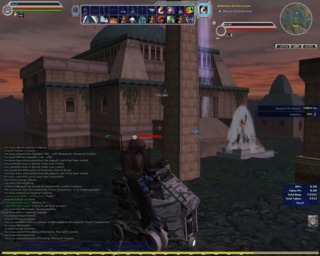
The Politician class has the ability to create a town for their guild with a city deed. The town is paid for by the residents property tax from how ever many buildings they have in the town and by the tax of players using vital buildings, like a Cloning Factory, buying a ticket from the Shuttleport, or buying from various placed vendors. These towns can be decorated with various items made by players, such as: Trees, Flower pots, Fountains, Statues, etc.
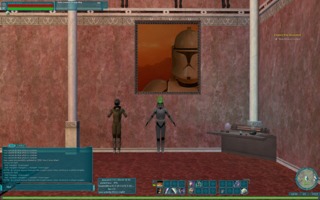
Players also have the option of placing their buildings outside of city limits, wherever there is space. These buildings can also be decorated with various nick-nacks players have picked up along their journey threw the galaxy. These houses can be used as a form of storage for players armor, weapons, and various quest rewards and mounted heads of creatures.
Vendors
Merchants and crafters can sell their products straight from their personal houses and tents with the use of vendors. These vendors are stationary NPCs that will hold and sell your items for you, for whatever price you set it at. You can have them advertise these products to people who are near your vendor with the use of general chat or /say.
Economy
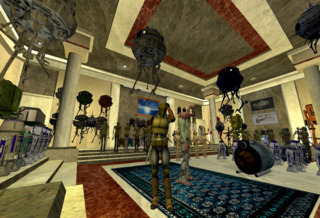
Star Wars Galaxies: An Empire Divided featured a very complex crafting system based on a replication of real-world mechanics. Each crafting profession specialized in a specific area (clothing, cooking, weapons, armor, etc) and learned new schematics as they progressed through that character's skill trees. Anything in the game could be crafted, including weapons, clothes, tools, traps, medicines, temporary buff foods, houses, furniture, vehicles, pets, even dice for games. Even a simple item like tea needed leaves to brew, water to boil, and a glass made from ground gemstones to put the tea in.
Players first needed resources. A resource table for each planet was updated weekly, essentially mapping out where the highest concentration of specific, randomized resources would appear at what locations "underneath" a planet. A surveyor could use a portable tool to see the percentage concentration of a resource in a specific area. Automated harvesters could be planted at open locations in the game world to generate that resource as long as they were supplied with maintenance money and a power resource (or until the next resource shift). Resources could then be used by the crafter, or split and sold on the market.
Organic resources came from creatures spawned around the game worlds, who could either be killed and harvested (for hide, meat, or bone) or milked (for milk or eggs). These were considered scouting abilities, so players with those skills could sell the items to edibles crafters.
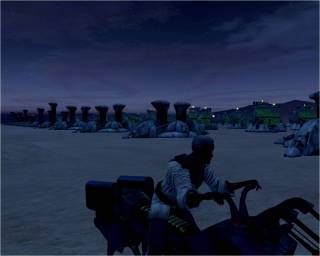
Weekly resources had randomly-generated stats in areas such as conductivity, malleability, and flavor (for organic items). Different schematics relied on different stats, causing resources to be excellent for building one item, but useless for another. A high quality in the stat specified by the schematic improved the quality of the final item. Some of the highest quality resource spawns could be mined, and the output then stored for years to come, giving value to weapons with server-capped stats made from such rare ores.
At the last crafting stage, crafters could add experimentation points to various weapons stats, allowing them to customize a weapon to client specifications (such as a weapon that hits harder, at the cost of firing slower). Craftable "crafting stations" and "crafting suits" with special skill attachments could boost the character's experimentation points, allowing veteran, established crafters to create better items than their counterparts with the same basic skills.
Advanced schematics also required components (such as pistol barrels or injector mechanisms); crafted using the same techniques and resources as entire basic items. The quality of these components affected the quality of the final product, and a crafter could easily make some money simply selling excellent-quality components to other crafters, who would then make the actual items. Some customization could also occur at this stage, such as armor "layers" that specialized the resistance stats of the final armor piece.
Crafters could purchase automated factory structures that lived in the gameworld, just like player housing. The crafter would create a blueprint using the above methods, then fill the factory with enough of the specific resources and let it mass produce the items for sale. Crafters could then sell these items on the planetary bazaar (a typical MMO "auction house"), or through the use of their own customized NPC vendors inside player housing decorated and advertised on the world map as a store.
Healing
Prior to the Combat Upgrade, characters had three bars - Health, Stamina, and Mind. Actions pulled from either the Stamina or Mind pool, which then recharged. Players were stunned if any bar dropped below 0, and could then be killed with a "deathblow" from an enemy player or creature. Because Health and Stamina could be buffed, but Mind could not, combat tended to focus on mind-attacking powers like Mind Shot or Two Handed Head Smash.
A character that was killed must clone. Upon revival, that character's bars were shortened by a set amount (signified by black portions of the bar, dubbed "black rot"). Bars could no longer refill past that point, and subsequent deaths would accumulate damage even further. Only Doctors could cure black rot, allowing those stats to return to their full potential.
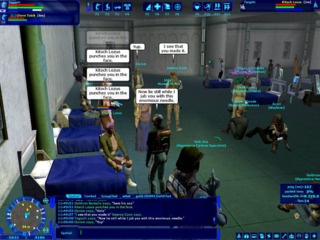
Doctors could only ply their trade at medical centers or with specially-designed portable droids. Because of this, an unwritten rule was that Doctors could be found serving "shifts" at medical centers in major cities (usually Coronet, Mos Eisley, and Theed). The community developed a protocol that injured players would enter and take a seat at an empty bed. Doctors would heal them using crafted medicines in the order they arrived, and players would use the /tip command to pay for services. Without tips, Doctors received no source of income, and no ability to pay for resources to craft their medicines.
Similarly, Dancers were required to heal accumulating "battle fatigue." Time spent in combat added to this stat, which lowered the effectiveness of all other stats over time. Like the Doctors, Dancers frequented cantinas so that they could be reliably found by players. Dancers could form bands, section off into private areas to try and segment customers, and use various social commands to try and attract business. Dancers also worked entirely off tips, and not surprisingly, the most successful were female toons dressed provocatively.
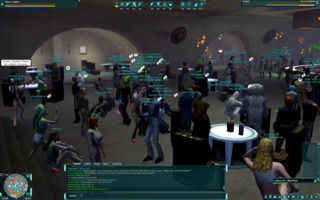
Dancers' roles were extremely repetitive and mostly automatic. Battle Fatigue was healed for players simply by watching a dancer, who could be set into motion with the /dance emote. Though some Dancers took their role seriously, using flourishes, costumes, and props, many (often as part of the Jedi grind, or a quick way to get cash as an alt) simply used macros to set up dance-bots. Their presence caused much contention inside the Dancer community, as well as pointing out the flaws in their role - you could literally do the job away from the keyboard.
The two systems were put in place to force interaction between combat and non-combat players. Accepted policies and a working economy did naturally form out of this. However, there were always lingering complaints about forced downtime out of combat, having to tip, not getting tipped, and so on. When the NGE moved the game moved away from its mostly sandbox elements, this forced interaction was removed entirely. Doctors now function as traditional healers/combat medics. Dancers now offer the buffs that Doctors did, with a buff-customizer window that ensures the dancer is playing at the keyboard.
Faction Bases
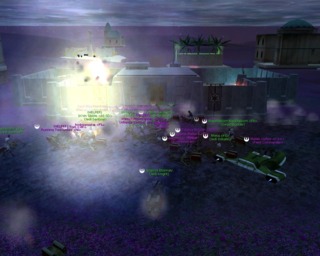
Although not restricted to player cites, the most common place you'll find player bases are inside of city limits. These bases are filled with patrolling NPCs that can be either Imperial or Rebel (respective to the owners faction). These bases are a form of world PVP instead of the instanced PVP you would find in other MMORPGs, such as World of Warcraft's 'battlegrounds'. Players can buy these bases from their factions recruiter for 'faction points'.
They can be destroyed with a large group of specific classes (i.e Bounty Hunters can jam the Uplink Terminal while a Spy slices the Security Terminal). PvE bases are vulnerable 24/7 but SF (Special Forces or PvP) bases are only vulnerable a few hours a day.
Destroying a Base
The classes you need to destroy a base and what their role is. Once all of the terminals are dealt with the base will blow up in 10 minutes.
- Bounty Hunter - Jams the Uplink Terminal
- Officer - Overloads the Primary Terminal
- Commando - Switch Overload at the Primary Terminal
- Smuggler - Slices the Security Terminal
- Medic - DNA Sequence to Overload Terminal
Smugglers
Though not explicitly a crafting class, Smugglers had some underworld abilities that could help out others... for a price. Specifically, Smugglers could "slice" weapons and armor to boost various stats - making sliced weapons quite valuable for an extra edge in PvP.
The downside was that sliced items were illegal. Players were randomly subjected to searches by factional NPCs guarding cities. If contraband was discovered, or the player tried to flee, they would temporarily be marked as an enemy and bring down the wrath of that faction.
Smugglers could also craft "spice" such as Booster Blue, Neutron Pixie, and good ol' Muon Gold. These offered big boosts to stats as an initial rush, followed later by a crashing debuff. These illegal drugs of the Star Wars universe were removed by the time of the New Game Enhancement gameplay revisions (Nov 15th, 2005), perhaps because being offered fantasy stimulants like "Thruster Head" and "Pyrepenol" wasn't "family friendly."
Bounty Hunters
One of the most contentious classes (but one it just wouldn't be Star Wars without), Bounty Hunters were mostly known for bringing PvP to everyone - whether they liked it or not!
As a Bounty Hunter, players got their missions from special terminals tucked away in the alleys of the major cities. Players could take generated PvE missions, or a PvP mission against a player who had attracted too much attention. Bounty Hunters used two types of disposable droids (crafted by droidsmiths) to find their target. The first could be launched from anywhere, and after a significant delay (of "searching"), reported the planet the target was currently on. The second droid scoured the current planet for the target, and dropped a waypoint for their last known location. Bounty Hunters also had class-exclusive weapons and armor (such as Boba Fett's Mandolorian gear).
Through use of these droids and some old-fashioned searching, Bounty Hunters would find their mark. An important note is that Bounty Hunters always got to fire first. The target never directly knew they were being targeted, or by whom. With the power to choose when combat started, Bounty Hunters could follow their targets, lie in wait, coordinate ambushes with friends, or all sorts of devious tricks and traps to kill their mark.
Prior to the NGE, Bounty Hunters were mostly used by the developers to keep the Jedi population in check. When a Jedi used their powers or lightsaber in view of others, their bounty went slightly up. As this accumulated, the reward for their defeat increased. This led to fledgling Jedi keeping their grind to secluded areas like Yavin or Endor, with only Jedi confident enough to defend themselves playing their class out in the open. And though the permadeath penalty was eventually dropped, the loss of XP to death by bounty hunter kept the Jedi looking over their shoulders.
However, Jedi had everything to lose from a defeat, while Bounty Hunters lost very little. This naturally led to Jedi finding ways to cheese their way out of fights. Common tactics were, again, grinding in solitary areas where an approaching player would be easily noticed, or fleeing into a house with restricted access (where the Hunter could not follow). The Rage of the Wookies expansion introduced a bug where bounty droids wouldn't work on the Rryatt Trail, rendering Jedi invisible to everything but a physical inspection of their floating nametag.
Some Jedi even paid for protection, or kept other players around as bodyguards while they leveled. However, the design of the system (anyone near a Jedi using their powers automatically "reported" them) meant that their bounty raised unavoidably in the process. A player's bounty did decrease somewhat when they defeated their hunter, so some Jedi also took advantage of bounty hunting guildmates to take the Jedi's mission and intentionally lose to them.
Complaints over the fairness of the entire system, and about forcing PvE Jedi into PvP fights, led to a change of the system with the NGE. Currently, players only gain a bounty from killing other players. Upon death, the defeated player has the option to contribute to a bounty against their killer. As this accumulates, their name floats to the top of the bounty terminals, where they will draw the attention of a hunter. Everything else is unchanged from that point. Since a player can only gain bounty through PvP, there is theoretically less punishment in sending a skilled PvP hunter after them.
Transportation
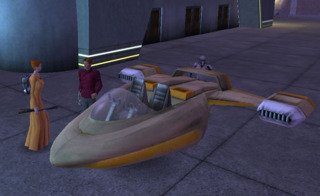
Transportation in Star Wars Galaxies consist of Vehicles, Shuttles, Ships, ride-able pets, and of course on foot.
Vehicles
The bread and butter of transportation. Vehicles are the most varied form of transportation (next to Ships). They come in all shapes, sizes, and speeds. From the slow, brittle but dirt cheap Speederbike to the sleek, rare, and fast AV-21 Landspeeder. Vehicles are destroyable in combat, if you are the owner of one of the rarer ones don't be surprised if the enemy goes straight for your ride instead of you. Damaged vehicles are repairable at a Parking Garage for a fee. When the health of a vehicle reaches 0 it is 'Disabled'. To repair a disabled vehicle you need a Vehicle Restoration Kit.
There are 21 attainable vehicles (as of the 11.3 patch). They vary from podracers, jetpacks, hover chairs, to the Speederbike.
Shuttleports and Starports
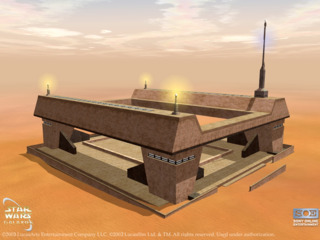
Shuttleports are the little brothers of Starports, they only go from city to city or town and are restricted to the same planet. These can be found in any city, town and player cities (with enough residents). Starports on the other hand are restricted to major cities, such as Mos Eisley on Tatooine or Theed on Naboo. These starports transport players from planet to planet. Both ports require the player to provide a ticket. Prices of tickets vary depending how the distance traveled.
Ride-able Pets (Mounts)
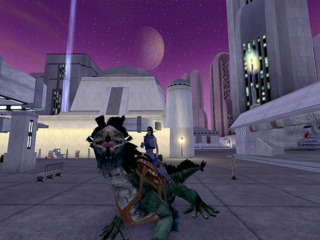
Mounts are essentially standard pets that are capable of supporting a player's weight. These pets have to be trained by Beast Handlers to be used as transports. These pets are usually slower than standard vehicles but are able to aid you in combat.
Ships
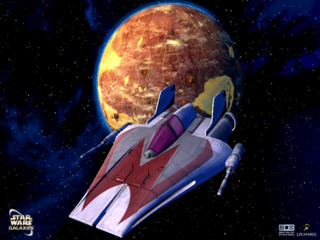
Ships are useable in the same sense as Starports, just without the use of tickets. You can access your ships from terminals at Starports and from there you can travel from Planet to Planet. You can launch your ship straight into space where you can traverse the space sector of the planet you launched from. Two types of ships are attainable, one are fight orientated and the other is essential a floating house, the interior being customizable with anything in your possession (Armor, decorations, weapons, furniture, etc)
The Grind to Jedi
The original grind to Jedi was fairly extreme in scope, and meant to limit the number of players who would achieve the coveted class.
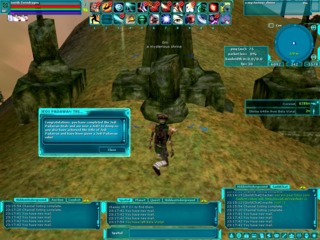
Originally, every new character had three professions tagged at random upon creation. The player had to completely master all three professions to unlock their Force Sensitive character. Players were initially given no clues. Later, "holocrons" could be looted that told the player the first and second needed profession, but not the third! Players would have to spend time equivalent to grinding multiple characters (losing the previous mastered profession to reclaim those skill points!) until they stumbled across the third profession.
Later, Force Sensitivity was unlocked through completing specific quests (like the Hero of Tatooine) and visiting specific locations (like Ben Kenobi's hut on Tatooine). Players that met these invisible requirements were visited by an NPC named the "Old Man," who would direct them to village of Aurillia on Dathomir (a 10-15 minute real-time drive each way, past some of the most dangerous creatures in the game).
At Aurillia, the player had to take a series of repeatable quests to receive Force Sensitive training. However, the player could only take a quest once every three weeks (!). Meanwhile, the player had to attain XP points through the regular game content, and trade this XP in to an Aurillian NPC for "Force Sensitive XP" at a significantly reduced exchange rate of 3 or 4:1 (!!). Only Force Sensitive XP could be spent on Force skill trees.
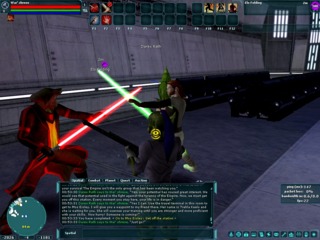
This continued as the player progressed up to Padawan and Jedi Knight. All the while, other players who had taken the Bounty Hunter profession acquired bounties placed on new Force Sensitives by the system. Using a series of tracking droids that could pinpoint a Jedi player's location on any planet, Bounty Hunters attacked without warning (Bounty Hunters always had the first shot) and engaged the budding Jedi in a forced PvP duel. If the Jedi was killed, the Hunter got his pay and the Jedi lost a percentage of their gained Force Sensitive XP, setting them back for days (!!!).
This led to many players looking for ways to game the system ("hologrinding" with macros, hiding on the Rryatt Trail where Bounty Hunters' droids wouldn't work, etc), and more than a few broken Padawan hearts.
Expansions
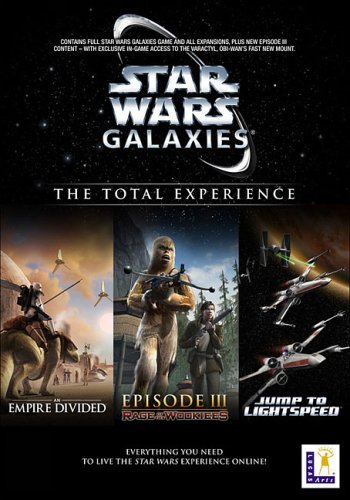
There has been 3 different expansion packs and 3 bundles of the game released since launch.
Jump to Lightspeed
- Added the Ability to create, customize, and pilot ships in 10 different space sectors
- Four new Pilot specific professions.
- Real-time space combat.
- Two new unique races: Ithorians and the Sullustan.
- 100 new missions added.
Rage of the Wookies
- New planet: Kashyyyk. The Homeland of the Wookies
- Cybernetic parts to give your character new abilities and strengths.
- 100 new story-driven missions
- Wearable medals. Mastering the Pilot profession is one of them.
- New weapons, armor and a brand new user-interface.
Trials of Obi-wan
- New planet: Mustafar. A lava drenched planet.
- Underground houses.
- 8 player mounts or vehicles.
- Three more vehicle storage spots in your datapad.
- 50 new quests.
- Able to aid Obi-wan in his quest for redemption.
Bundles
- The Total Experience - An Empire Divided, Jump to Light Speed, Rage of the Wookies
- Starter Kit - An Empire Divided, Jump to Lightspeed, includes the New Game Enhancement (NGE) patch and a X-wing or a TIE fighter
- The Complete Online Adventure - The original game (An Empire Divided) and every expansion (Trials of Obi-wan, Jump to Lightspeed, Rage of the Wookies). A AT-RT ride-able vehicles and a slide show of 800 images of screenshots and concept art with one-hour of in-game music, Queen Amidala transport ship
Shutdown
On June 24th, 2011 Sony Online Entertainment announced that SOE and LucasArts have come to an agreement to shutdown Star Wars Galaxies. The shutdown goes into effect on December 15th, 2011 with an in-game event.
Closure
The date announced for this is December 15, 2011. According to the announcement, both LucasArts and SOE came to the agreement. "If you are an active subscriber in good standing as of September 15, 2011, then you can play for free for the final months. Players wishing to play through the end of the game and participate in the galaxy-ending event planned for the last week of live service in December will need to re-activate or join the game on or before September 15th. No new or reactivated accounts will be accepted after September 15, 2011

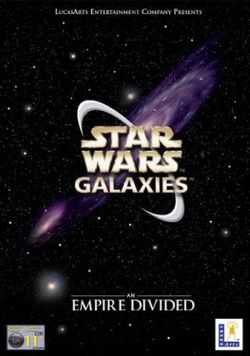
 PC
PC




























